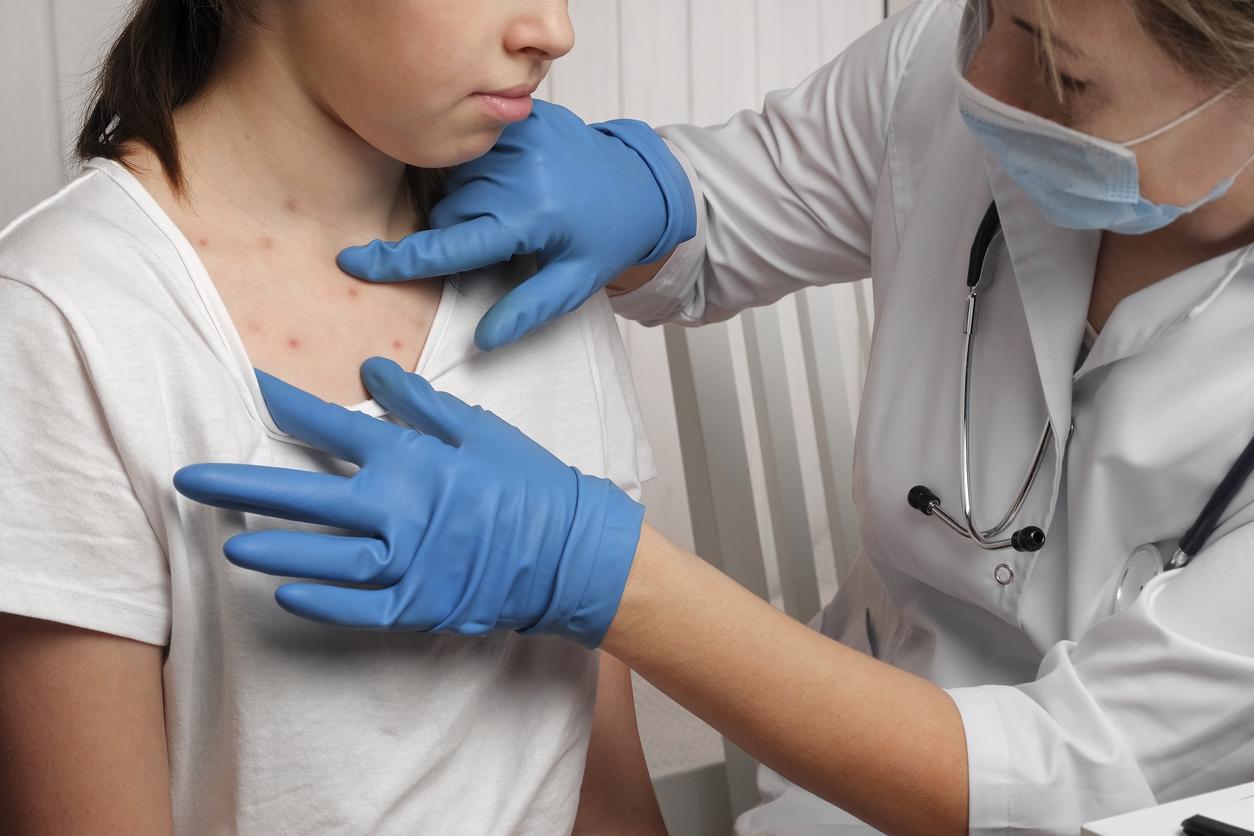- Cervical cancer: what symptoms?
- Cervical cancer: how is screening done?
- Cervical cancer: what risk factors?
- Cervical cancer: what are the stages of diagnosis?
- Cervical cancer: how is it treated?
- Cervical cancer: what is the life expectancy?
Cervical cancer is the 12th leading cause of cancer in women. Each year, nearly 3,000 women develop this female cancer and 1,100 women die from it, whereas for the World Health Organization, cervical cancer would be totally eliminable thanks to two effective and complementary interventions: screening for precancerous lesions and the vaccine. against human papillomavirus (HPV) infections. Cancer of the cervix is in fact attributable in the vast majority of cases to a sexually transmitted HPV infection.
Cervical cancer: what symptoms?
“When the cancer is at an early stage, there are no symptoms. Diagnosis is made incidentally during a biopsy. Or when there is a conization” explains Dr. Julia Maruani, gynecologist and general secretary of the French Society of Colposcopy and Cervico-Vaginal Pathology (SFCPCV).
When the symptoms appear, they are not specific:
- Metrorrhagia (spontaneous bleeding between periods)
- Pain during intercourse or bleeding after intercourse
- Leucorrhea especially in a postmenopausal person
- Lower back pain
So many gynecological symptoms that should lead to consultation.
Cervical cancer: how is screening done?
Screening can be done by a general practitioner, a gynecologist, a midwife or a medical biologist. “The examination is done in the lithotomy position. The doctor inserts a speculum into the vagina and takes cells from the cervix. It takes a few minutes and is usually not painful. This cervico-uterine sample is then sent for laboratory analysis.
>> At what age should you get tested? Screening is for all women between 25 and 65 who have had at least 1 sexual intercourse.
Since May 2018, the cervical cancer screening (CCU) relies on a national organized screening program (PNDO) such as breast and colon cancer. Women who are not up to date with their screening receive a letter inviting them to be screened, and in this context, the screening is reimbursed at 100%.
For women between 25 and 29 years old, the screening test is carried out by cytological examination (analysis of cells under a microscope). If this is the first screening, it must be repeated 1 year later. If the results of these first two screenings 1 year apart are normal, you will have to carry out a new screening 3 years later (cytological examination or HPV test depending on your age).
For women from the age of 30, the Haute Autorité de Santé recommends that a virological test (called HPV-HR test) replaces the cytological examination. This test is carried out 3 years after the last cytological examination, the result of which is normal. A new test is then repeated every 5 years, until the age of 65, when the test result is negative.
>> Do you have to get tested when you are vaccinated against the HPV virus? “Vaccinated or not, screening is necessary because, if the vaccine protects against most of the viruses responsible for cervical cancer, it does not protect against all. Vaccination and screening are two complementary prevention methods for cervical cancer,” insists the gynecologist.
>> Is cervicitis cancer? This has nothing to do with. It’s just an infection of the cervix by a bacterium or parasite.
Cervical cancer: what risk factors?
“The main risk factor is a persistent HPV infection that is caught through sexual intercourse. The condom can provide 70% protection because the human papillomavirus is also transmitted manually during sexual caresses” explains Dr. Maruani. “Most often this infection is transient and disappears on its own. But sometimes it persists in the mucous membrane of the cervix and, over time, this creates so-called precancerous lesions (after 5 to 10 years) even cancers (after 10 to 20 years). Hence the importance of screening.”
Certain co-risk factors favor the persistence of HPV : in the first place tobacco. But also acquired immunodepression (HIV) or immunosuppressive treatments (prescribed in the event of transplants or autoimmune or rheumatic diseases).
>> At what age does it occur? The median age is 53 years: it is a cancer of young women (one can suffer from it at 30 years old) with a peak of mortality at 60 years old.
Cervical cancer: what are the stages of diagnosis?
When the test reveals an abnormality, a colposcopy is performed with a possible biopsy. If this reveals a pre-cancerous lesion: a conization is performed.
If the lesion is cancerous, an extension assessment is made: a pelvic MRI makes it possible to measure the size of the tumor and its possible extension to neighboring organs and to define the stage of the cancer.
>> The different stages of cervical cancer
- Stage I : the tumor is strictly localized to the cervix.
- Stage II : the tumor has grown into the surrounding areas (vagina, tissue surrounding the uterus).
- Stage III : the tumor affects 2/3 of the vagina and/or the peri-uterine tissue.
- Stage IV : the cancer begins to spread to neighboring organs (bladder, rectum, etc.).
Cervical cancer: how is it treated?
Therapeutic choices are made according to the patient: during a multidisciplinary consultation meeting, several doctors from different specialties come together to discuss the best possible treatments.
“Surgery is mainly used to remove a tumor limited to the cervix. The challenge is to remove the entire tumor and limit the risk of recurrence. We can also remove the uterus (hysterectomy), lymph nodes lymphatics…” explains the gynecologist.
>> Can we then consider a pregnancy? “For a young woman wishing to keep the possibility of having children, we offer an onco-fertility consultation. Treatments will be discussed depending on the pregnancy plan and conservative surgery (which consists of removing only the cervix and keeping the uterus) is considered. Provided, of course, that the tumor is at an early stage” adds Dr. Maruani.
On advanced stage cancers (large tumors or tumors that have affected organs near the cervix), what is called concurrent chemoradiotherapy is performed: radiotherapy, chemotherapy and brachytherapy are used in combination.
In concrete terms, the protocol most often consists of carrying out 5 sessions of external radiotherapy and one session of chemotherapy, per week, for 5 weeks. And 8-10 days after the end of the external radiation therapy sessions, brachytherapy is performed. These treatments cause many side effects, which are also subject to medical treatment.
Cervical cancer: what is the life expectancy?
It is a cancer that can be treated well when detected at an early stage. Five-year survival is 63% for all stages. But if it is 90% at stage 1, it is only 35% at stage 4.
With the development of vaccination we will see fewer and fewer precancerous lesions since the risk decreases by 90% in vaccinated women.
For 20 years, screening for precancerous lesions has halved the number of new cases of cancer, as well as the number of deaths. Some scientists even believe that the disease could disappear within 10-20 years in countries where the rate of vaccination of young people against the HPV virus is high,” rejoices the gynecologist.
>> What follow-up after cervical cancer? The follow-up is carried out in conjunction with the multidisciplinary team that took care of the patient. We see the patient 2 to 3 times a year for 2 years and then twice a year. The aim is to manage the consequences of the treatments to improve the quality of life of the patients and to ensure monitoring to detect any local or general recurrences.
Our expert : Dr. Julia Maruani, gynecologist and general secretary of the French Society of Colposcopy and Cervico-Vaginal Pathology (SFCPCV)
Read also :
- Understand his smear
- Cervical cancer: the effectiveness of the HPV vaccine demonstrated
- Tobacco, a risk factor for female cancers
- Cervical cancer: a risk even after 65 years


















